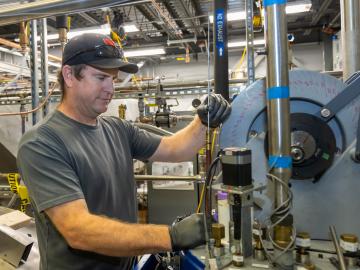Filter News
Area of Research
- Advanced Manufacturing (2)
- Biology and Environment (20)
- Clean Energy (22)
- Climate and Environmental Systems (1)
- Computational Engineering (1)
- Computer Science (1)
- Fusion and Fission (3)
- Isotope Development and Production (1)
- Isotopes (15)
- Materials (38)
- Materials for Computing (3)
- National Security (20)
- Neutron Science (13)
- Nuclear Science and Technology (5)
- Quantum information Science (1)
- Supercomputing (24)
News Type
News Topics
- (-) Biomedical (25)
- (-) Clean Water (7)
- (-) Critical Materials (12)
- (-) Cybersecurity (23)
- (-) Isotopes (25)
- (-) Machine Learning (17)
- (-) Mercury (6)
- (-) Physics (41)
- (-) Quantum Computing (10)
- (-) Space Exploration (3)
- 3-D Printing/Advanced Manufacturing (55)
- Advanced Reactors (12)
- Artificial Intelligence (31)
- Big Data (13)
- Bioenergy (40)
- Biology (42)
- Biotechnology (10)
- Buildings (21)
- Chemical Sciences (37)
- Climate Change (36)
- Composites (11)
- Computer Science (69)
- Coronavirus (23)
- Decarbonization (31)
- Education (3)
- Element Discovery (1)
- Energy Storage (55)
- Environment (72)
- Exascale Computing (11)
- Fossil Energy (1)
- Frontier (16)
- Fusion (21)
- Grid (22)
- High-Performance Computing (34)
- Hydropower (2)
- ITER (3)
- Materials (65)
- Materials Science (62)
- Mathematics (3)
- Microscopy (25)
- Molten Salt (2)
- Nanotechnology (32)
- National Security (32)
- Net Zero (5)
- Neutron Science (57)
- Nuclear Energy (39)
- Partnerships (26)
- Polymers (17)
- Quantum Science (28)
- Renewable Energy (1)
- Security (17)
- Simulation (12)
- Statistics (2)
- Summit (22)
- Sustainable Energy (44)
- Transformational Challenge Reactor (4)
- Transportation (36)
Media Contacts

Associate Technician Sean Hollander is the keeper of the Fundamental Neutron Physics Beamline, which is operated by the Physics Division at the Spallation Neutron Source at ORNL, where scientists use neutrons to study all manner of matter.

Scientists have uncovered the properties of a rare earth element that was first discovered 80 years ago at the very same laboratory, opening a new pathway for the exploration of elements critical in modern technology, from medicine to space travel.

Scientists at ORNL completed a study of how well vegetation survived extreme heat events in both urban and rural communities across the country in recent years. The analysis informs pathways for climate mitigation, including ways to reduce the effect of urban heat islands.

A collection of seven technologies for lithium recovery developed by scientists from ORNL has been licensed to Element3, a Texas-based company focused on extracting lithium from wastewater produced by oil and gas production.

Two different teams that included Oak Ridge National Laboratory employees were honored Feb. 20 with Secretary’s Honor Achievement Awards from the Department of Energy. This is DOE's highest form of employee recognition.

EPB, ORNL announce plans for research collaborative focused on energy resilience, quantum technology
EPB and ORNL marked 10 years of collaboration with the announcement of the new Collaborative for Energy Resilience and Quantum Science. The new joint research effort will focus on utilizing Chattanooga’s highly advanced and integrated energy and communications infrastructure to develop technologies and best practices for enhancing the resilience and security of the national power grid while accelerating the commercialization of quantum technologies.

Louise Stevenson uses her expertise as an environmental toxicologist to evaluate the effects of stressors such as chemicals and other contaminants on aquatic systems.

Corning uses neutron scattering to study the stability of different types of glass. Recently, researchers for the company have found that understanding the stability of the rings of atoms in glass materials can help predict the performance of glass products.

It would be a challenge for any scientist to match Alexey Serov’s rate of inventions related to green hydrogen fuel. But this researcher at ORNL has 84 patents with at least 35 more under review, so his electrifying pace is unlikely to slow down any time soon.





